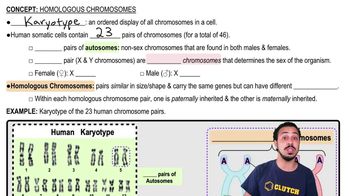Table of contents
- 1. Introduction to Biology2h 42m
- 2. Chemistry3h 40m
- 3. Water1h 26m
- 4. Biomolecules2h 23m
- 5. Cell Components2h 26m
- 6. The Membrane2h 31m
- 7. Energy and Metabolism2h 0m
- 8. Respiration2h 40m
- 9. Photosynthesis2h 49m
- 10. Cell Signaling59m
- 11. Cell Division2h 47m
- 12. Meiosis2h 0m
- 13. Mendelian Genetics4h 44m
- Introduction to Mendel's Experiments7m
- Genotype vs. Phenotype17m
- Punnett Squares13m
- Mendel's Experiments26m
- Mendel's Laws18m
- Monohybrid Crosses19m
- Test Crosses14m
- Dihybrid Crosses20m
- Punnett Square Probability26m
- Incomplete Dominance vs. Codominance20m
- Epistasis7m
- Non-Mendelian Genetics12m
- Pedigrees6m
- Autosomal Inheritance21m
- Sex-Linked Inheritance43m
- X-Inactivation9m
- 14. DNA Synthesis2h 27m
- 15. Gene Expression3h 20m
- 16. Regulation of Expression3h 31m
- Introduction to Regulation of Gene Expression13m
- Prokaryotic Gene Regulation via Operons27m
- The Lac Operon21m
- Glucose's Impact on Lac Operon25m
- The Trp Operon20m
- Review of the Lac Operon & Trp Operon11m
- Introduction to Eukaryotic Gene Regulation9m
- Eukaryotic Chromatin Modifications16m
- Eukaryotic Transcriptional Control22m
- Eukaryotic Post-Transcriptional Regulation28m
- Eukaryotic Post-Translational Regulation13m
- 17. Viruses37m
- 18. Biotechnology2h 58m
- 19. Genomics17m
- 20. Development1h 5m
- 21. Evolution3h 1m
- 22. Evolution of Populations3h 53m
- 23. Speciation1h 37m
- 24. History of Life on Earth2h 6m
- 25. Phylogeny2h 31m
- 26. Prokaryotes4h 59m
- 27. Protists1h 12m
- 28. Plants1h 22m
- 29. Fungi36m
- 30. Overview of Animals34m
- 31. Invertebrates1h 2m
- 32. Vertebrates50m
- 33. Plant Anatomy1h 3m
- 34. Vascular Plant Transport1h 2m
- 35. Soil37m
- 36. Plant Reproduction47m
- 37. Plant Sensation and Response1h 9m
- 38. Animal Form and Function1h 19m
- 39. Digestive System1h 10m
- 40. Circulatory System1h 49m
- 41. Immune System1h 12m
- 42. Osmoregulation and Excretion50m
- 43. Endocrine System1h 4m
- 44. Animal Reproduction1h 2m
- 45. Nervous System1h 55m
- 46. Sensory Systems46m
- 47. Muscle Systems23m
- 48. Ecology3h 11m
- Introduction to Ecology20m
- Biogeography14m
- Earth's Climate Patterns50m
- Introduction to Terrestrial Biomes10m
- Terrestrial Biomes: Near Equator13m
- Terrestrial Biomes: Temperate Regions10m
- Terrestrial Biomes: Northern Regions15m
- Introduction to Aquatic Biomes27m
- Freshwater Aquatic Biomes14m
- Marine Aquatic Biomes13m
- 49. Animal Behavior28m
- 50. Population Ecology3h 41m
- Introduction to Population Ecology28m
- Population Sampling Methods23m
- Life History12m
- Population Demography17m
- Factors Limiting Population Growth14m
- Introduction to Population Growth Models22m
- Linear Population Growth6m
- Exponential Population Growth29m
- Logistic Population Growth32m
- r/K Selection10m
- The Human Population22m
- 51. Community Ecology2h 46m
- Introduction to Community Ecology2m
- Introduction to Community Interactions9m
- Community Interactions: Competition (-/-)38m
- Community Interactions: Exploitation (+/-)23m
- Community Interactions: Mutualism (+/+) & Commensalism (+/0)9m
- Community Structure35m
- Community Dynamics26m
- Geographic Impact on Communities21m
- 52. Ecosystems2h 36m
- 53. Conservation Biology24m
11. Cell Division
Organization of DNA in the Cell
Problem 2
Textbook Question
Add labels to the figure that follows, which illustrates duplicated chromosomes.

 Verified step by step guidance
Verified step by step guidance1
Step 1: Identify the structure labeled '1' in the first image. This represents the duplicated chromosomes, which consist of two identical sister chromatids joined together.
Step 2: Label the structure marked '2' in the first image. This is the centromere, the region where the sister chromatids are tightly connected and where spindle fibers attach during cell division.
Step 3: Label the structure marked '3' in the first image. These are the sister chromatids, which are identical copies of the chromosome formed during DNA replication.
Step 4: In the second image, identify the bracketed region. This represents the duplicated chromosome, which includes two sister chromatids.
Step 5: Label the pointed region in the second image. This is the centromere, the constricted area where the chromatids are joined and spindle fibers attach during mitosis or meiosis.
 Verified video answer for a similar problem:
Verified video answer for a similar problem:This video solution was recommended by our tutors as helpful for the problem above
Video duration:
1mPlay a video:
Was this helpful?
Key Concepts
Here are the essential concepts you must grasp in order to answer the question correctly.
Chromosome Structure
Chromosomes are long, thread-like structures made of DNA and proteins that carry genetic information. In eukaryotic cells, chromosomes are linear and exist in pairs, while in prokaryotes, they are typically circular. The image depicts duplicated chromosomes, which consist of two sister chromatids joined at a region called the centromere, essential for accurate cell division.
Recommended video:
Guided course

Homologous Chromosomes
DNA Replication
DNA replication is the biological process of producing two identical replicas of DNA from one original DNA molecule. This process is crucial during cell division, ensuring that each daughter cell receives an exact copy of the genetic material. The image illustrates chromosomes that have undergone replication, showing the duplicated structure necessary for mitosis or meiosis.
Recommended video:
Guided course

Introduction to DNA Replication
Cell Division
Cell division is the process by which a parent cell divides into two or more daughter cells. In eukaryotes, this occurs through mitosis (for somatic cells) or meiosis (for gametes). The duplicated chromosomes in the image are vital for this process, as they ensure that genetic information is accurately distributed to the daughter cells during division.
Recommended video:
Guided course

Importance of Cell Division

 6:52m
6:52mWatch next
Master Organization of DNA in the Cell with a bite sized video explanation from Jason
Start learningRelated Videos
Related Practice
Multiple Choice
The region of a chromosome in which the two double strands of replicated DNA are held together is called __________.
1832
views
